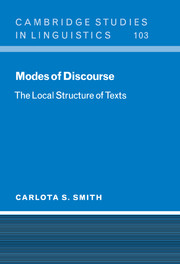Book contents
- Frontmatter
- Contents
- Preface
- Introduction
- PART I DISCOURSE STRUCTURE
- PART II LINGUISTIC ANALYSIS OF THE DISCOURSE MODES
- PART III SURFACE PRESENTATIONAL FACTORS
- 7 Subjectivity in texts
- 8 The contribution of surface presentation
- 9 Non-canonical structures and presentation
- PART IV DISCOURSE MODES AND THEIR CONTEXT
- Appendix A The Texts
- Appendix B Glossary
- References
- General index
- Index of names
9 - Non-canonical structures and presentation
Published online by Cambridge University Press: 18 June 2010
- Frontmatter
- Contents
- Preface
- Introduction
- PART I DISCOURSE STRUCTURE
- PART II LINGUISTIC ANALYSIS OF THE DISCOURSE MODES
- PART III SURFACE PRESENTATIONAL FACTORS
- 7 Subjectivity in texts
- 8 The contribution of surface presentation
- 9 Non-canonical structures and presentation
- PART IV DISCOURSE MODES AND THEIR CONTEXT
- Appendix A The Texts
- Appendix B Glossary
- References
- General index
- Index of names
Summary
Canonical sentences furnish the background for variation. I consider here structures that play off this background with different word orders and syntactic structures. Non-canonical structures have special force, because of their features and because they depart from the basic case. Writers choose structures. I assume that choice is based on assessment, not necessarily conscious, of how a structure affects interpretation in a specific context.
Sentence-internally, non-canonical structures highlight or downplay the material in certain positions. Syntax may enhance connectedness between sentences by placing information that is familiar to a discourse first in a sentence. A given structure may allow or block a topic relation with the following sentence. Changes in direction may be conveyed by sentences that lack such connection, and by breaks in the syntactic pattern. Thus syntactic patterning affects the organization and progression of discourse passages.
This chapter concentrates on non-canonical structures that affect topic and sentence connectedness, the main factors of presentational progression. I draw on discussions in the literature of a variety of constructions. Together they give a sense of the different tools that the language makes available. I will also look briefly at multi-clause sentences, and will discuss paragraphs as text units.
The interpretations involve inference. Semantic presuppositions are close to the linguistic forms: they are triggered by particular structures, such as cleft sentences and temporal clauses; and by particular forms such as the focus particles “only” and “even.” Pragmatic presuppositions of familiarity status and linking inferences depend on context, world knowledge, and convention.
- Type
- Chapter
- Information
- Modes of DiscourseThe Local Structure of Texts, pp. 213 - 240Publisher: Cambridge University PressPrint publication year: 2003



